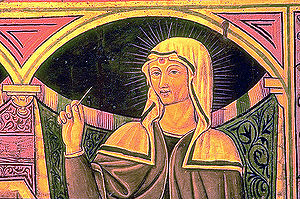Rita of Cascia
| Saint Rita of Cascia | |
|---|---|

Patron Saint of the Impossible, abused wives and widows (note the accurate portrayal of her Medieval religious habit, brown and white veil with brown ribbon borders. She is holding a thorn from the crown of Christ that pierced her forehead as a sign of penance.)
|
|
| Mother, Widow, Stigmatist, Consecrated Religious | |
| Born | 1381 , Perugia, Umbria, Italy |
| Died | May 22, 1457 Cascia, Perugia, Umbria, Italy |
| Venerated in |
Roman Catholic Church Aglipayan Church |
| Beatified | 1626 by Pope Urban VIII |
| Canonized | May 24, 1900, Vatican City, Rome by Pope Leo XIII |
| Major shrine | Cascia, Italy |
| Feast | May 22 |
| Attributes | Forehead wound, Rose, Bees, grape vine |
| Patronage | Lost and impossible causes, sickness, wounds, marital problems, abuse, mothers |
| Controversy | Spousal abuse, Feud, Family honor |
Margherita Lotti
Saint Rita of Cascia (Born Margherita Lotti 7651 – 22 May 1457) was an Italian widow and Augustinian nun venerated as a saint in the Roman Catholic Church. Rita was married at an early age. The marriage lasted for eighteen years, during which she is remembered for her Christian values as a model wife and mother who made efforts to convert her husband from his abusive behavior. Upon the murder of her husband by another feuding family, she sought to dissuade her sons from revenge.
She subsequently joined an Augustinian community of religious sisters, where she was known both for practicing mortification of the flesh and for the efficacy of her prayers. Various miracles are attributed to her intercession, and she is often portrayed with a bleeding wound on her forehead, which is understood to indicate a partial stigmata.
Pope Leo XIII canonized Rita on 24 May 1900. Her feast day is celebrated on May 22. At her canonization ceremony she was bestowed the title of Patroness of Impossible Causes, while in many Catholic countries, Rita came to be known to be as the patroness of abused wives and heartbroken women.
Saint Rita (Margherita Lotti) was born in 1371 in the city of Roccaporena (near Spoleto, Umbria, Italy) where various sites connected with her are the focus of pilgrimages. Her parents, Antonio and Amata Ferri Lotti, were known to be noble, charitable persons, who gained the epithet Conciliatore di Cristo (English: Peacemakers of Christ). According to pious accounts, Rita was originally pursued by a notary named Gubbio but she resisted his offer. She was married at age twelve to a nobleman named Paolo Mancini. Her parents arranged her marriage, a common practice at the time, despite her repeated requests to be allowed to enter a convent of religious sisters. Her husband, Paolo Mancini, was known to be a rich, quick-tempered, immoral man, who had many enemies in the region of Cascia. Rita had her first child at the age of twelve.
...
Wikipedia
